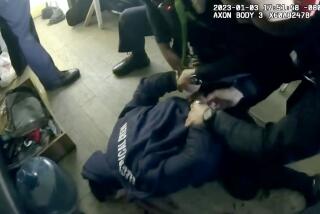Slain football star’s family sues Sheriff’s Department
- Share via
The family of slain high school football star Jamiel Shaw II is suing the Los Angeles County Sheriff’s Department, alleging that the department was negligent in releasing Shaw’s suspected killer from prison despite his illegal-immigrant status.
The lawsuit, filed Friday in Los Angeles County Superior Court, names Sheriff Lee Baca as a defendant and alleges that he “knew or should have known that they were releasing a convicted felon and illegal alien with an extensive history of gang violence into the Los Angeles community to perpetrate killings against African Americans.”
Shaw, 17, a running back who was recruited by Stanford and Rutgers universities, was gunned down in March 2008. Prosecutors allege that Pedro Espinoza, a reputed member of the 18th Street gang who was in the United States illegally, killed Shaw. Espinoza, 19, had been released from jail a day before the shooting, after serving time for an earlier offense.
Sheriff’s spokesman Steve Whitmore said he would not comment on the details of the lawsuit because the department had not received it.
“It’s obvious this young man’s death is a tragedy,” he said. “We will do our part in telling the whole story.”
Shaw’s death led to the proposal of Jamiel’s Law, a controversial ballot initiative that would have allowed police to arrest illegal-immigrant gang members for being in the country illegally.
The petition failed to get enough signatures to qualify for the May ballot.
The lawsuit also alleges wrongful death, civil rights violations and a violation of the U.S. Immigration and Nationality Act, which empowers local police agencies to enforce immigration law.
“We think that [Shaw’s death] could have been avoided, had they simply made use of the resources they had,” said Wesley Profit, an attorney representing Shaw’s family. “It’s not as if [Espinoza] was new to the system. . . . He’s been in the system since he was a juvenile.”
Some immigration law experts said the lawsuit was proposing an unprecedented legal theory in arguing that a sheriff or warden could be held liable for releasing an illegal immigrant who goes on to commit a violent crime.
Immigration and criminal law attorney Peter Schey said he did not think that the Immigration and Nationality Act was intended to hold local agencies responsible for enforcing immigration law.
“That would be an enormous, complex and extremely onerous requirement to place on every police department,” said Schey, who is also the executive director of the Center for Human Rights and Constitutional Law. “It would be virtually impossible to enforce.”
Whitmore said at the time of Espinoza’s release that the Sheriff’s Department screened only inmates with prior criminal records or those who told deputies that they were foreign born. Espinoza slipped under the radar because he claimed to be born in the United States and only had a juvenile record, according to Whitmore.
Beginning in October of last year, partly due to Shaw’s killing, the Sheriff’s Department began screening all known gang members for immigration status, Whitmore said. In recent weeks, a new federal program known as “Secure Communities” began allowing sheriff’s officials to search a larger immigration database to identify those who are illegally in the country, he said.
Espinoza was ordered by a judge last June to stand trial in Shaw’s slaying. He remains in custody.
--
More to Read
Sign up for Essential California
The most important California stories and recommendations in your inbox every morning.
You may occasionally receive promotional content from the Los Angeles Times.











